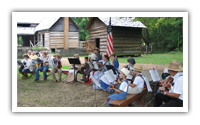


Both sides in the American Civil War considered Kentucky a key to victory. Lincoln is reported to have said that he hoped to have God on his side, but he must have Kentucky. From Cumberland Gap in the east to Columbus in the west, fighting raged for control of crucial mountain passes, navigable rivers and railroad junctions. The war divided Kentucky more tragically than any other state; for Kentuckians, it truly was a brothers’ war. It is scarcely an exaggeration to say that the Confederacy would have won the war if it could have gained Kentucky, and, conversely, that the Union’s success in retaining Kentucky as a base for invasions of the Confederate heartland brought eventual Union victory.
– James M. McPherson – Noted Civil War Historian
BLACK PATCH TOBACCO WARS
In the early twentieth century many producers of “black patch” tobacco found they could no longer sell their tobacco crops at a profit. A monopoly existed which set fixed prices for purchasing tobacco. The farmers organized opposition to the monopoly. Ultimately 250 masked night riders pursued tobacco executives and burned three warehouses. The Pennyroyal Area Museum in Hopkinsville and the Adsmore House and Gardens and Amoss House Museum in Princeton explain this event. Both communities recreate the Night Rider raids each fall. For information call Hopkinsville: ; Adsmore: ; Amoss House Museum: .
CHEROKEE STATE PARK
Aurora - The resort park was a blacks-only state park in Kentucky during the segregation area - only the third such state park in the nation. It is now part of Kenlake State Resort Park.
COLUMBUS-BELMONT STATE PARK
Columbus, . On display is a massive chain and six-ton anchor used to block the passage of Union gunboats down the Mississippi River. There are also several Confederate cannons, a network of earthen trenches and an impressive new museum in what was once a Civil War hospital. There is a small admission fee for the museum. A re-enactment of the Civil War Battle of Belmont takes place the 2nd weekend of each October. From Exit 1 off the Purchase Pkwy, go north on US 51 to Clinton then northwest on KY 58 to Columbus. Or from Mayfield follow KY 80 west to Columbus.
 FORT HEIMAN
FORT HEIMAN
One of the 3 forts constructed by the Confederates in an attempt to control traffic on the Cumberland and Tennessee Rivers. Fort Heiman was built on the west bank of the Tennessee River (20 miles east of Murray). In late 2006, the site was incorporated into the Fort Donalson National Battlefield. In the future, the visitor experience at Fort Donalson will be expanded and enhanced to relate the story of all 3 forts and their impact on the Civil War.
FORT SMITH
The Smithland Chamber of Commerce can provide directions, . After General Ulysses S. Grant seized Paducah in 1861, Union forces constructed the star-shaped, earthen Fort Smith at the confluence of the Cumberland and Ohio Rivers. By 1864, the fort was manned by a contingent of the 13th US Colored Heavy Artillery. A Civil War battle re-enactment is held on the site in even-numbered years.
HOTEL METROPOLITAN
Opening 2007 as an African-American Heritage Museum. This 1908 hotel housed famous African-American entertainers and sports figures during segregation. Well-known musicians and travelling performers such as Louis Armstrong, Duke Ellington, Cab Calloway, Chick Webb's orchestra, B.B. King, Bobby "Blue" Bland and Ike and Tina Turner were guests of Maggie Steed's Hotel Metropolitan, the only hotel for African Americans in the area.
JEFFERSON DAVIS MONUMENT STATE HISTORIC SITE
US 68, Fairview, . The monument is a 351-foot-high concrete obelisk that marks the site where, on June 3, 1808, Jefferson Davis was born. Ride an elevator to an observation room atop the structure for a panoramic view of the western Kentucky countryside. A fee is charged to ride the elevator. The Jefferson Davis Birthday Celebration is held each year the first weekend in June. Event festivities include living history camps, battle re-enactments, day and night artillery demonstrations. Saturday night's grand ball with period music and dress is open to the public. Open May - October
 LAND BETWEEN THE LAKES
LAND BETWEEN THE LAKES
Remnants of the past can be seen throughout LBL. You can study the ruins of two iron furnaces at LBL: Center Furnace, located near the Nature Station, and the Great Western Furnace, near The Homeplace. Civil War Forts: In 1861, Governor Harris of Tennessee authorized construction of two forts to protect the rivers: Fort Henry, on the east bank of the Tennessee River, and Fort Donelson, on the west bank of Cumberland, both near the south end of LBL.
LLOYD TILGHMAN HOME & CIVIL WAR MUSEUM
631 Kentucky Avenue, Paducah, . Hours: Fri. & Sat., Noon-4 PM. Museum exhibits in the 1852 home of General Lloyd Tilghman, CSA, highlight western Kentucky's role during the War Between the States.
MARKET HOUSE MUSEUM (WILLIAM CLARK)
121 S Second St, Paducah, .General history museum with 4800 square feet of exhibits outlining founding of the town by explorer William Clark, plus a Civil War artifact room and the entire woodwork interior of the 1877 List Drug Store. Open Monday-Saturday noon - 4 PM. Closed Sunday & major holidays. Open by appointment for school and group tours.
OAK GROVE WAR MEMORIAL WALKING TRAIL
Located just off 1-24’s exit 86, this mile-long trail features markers honoring all U.S. wars and conflicts. Special monuments are on site for Vietnam War Veterans and a poem for soldiers. Casually stroll along the well-lit trail featuring plants native to this area. Picnic tables are available to enjoy a special meal at the park.
WICKLIFFE MOUNDS STATE HISTORIC SITE
94 Green St., Wickliffe,. An archaeological site of prehistoric Native Americans. It was occupied from about AD 1100 to 1350. See exhibits from1930’s excavations and a museum consisting of 3 excavated mounds with archaeological features and a mural of the Native American Village. Open daily May - Sept. Call for days Oct - April.
 CHEROKEE TRAIL OF TEARS
CHEROKEE TRAIL OF TEARS
In 1830, with the support of President Andrew Jackson, Congress passed the Indian Relocation Act. The Cherokee initially prevailed in court in their fight against removal from their homeland in the Smokey Mountains. However, a handful of Cherokee approved a treaty exchanging the Cherokee homeland for $5 million and 7 million acres in Oklahoma. Congress ratified the treaty in spite of a protesting petition signed by 16,000 Cherokee. The Cherokee were relocated to Oklahoma. During the overland march in the harsh winter of 1838-39, 4,000 of the Cherokee perished in one of the darker times in American history. The route they followed is known as the Trail of Tears. The trail encompasses about 2,200 miles of land and water routes and traverses portions of nine states. Its approximate route through Kentucky can be retraced today by following the highway markers on US 41, KY 91 and US 641.
THE TRAIL OF TEARS COMMEMORATIVE PARK
Hopkinsville, : This historic park is one of the few documented sites of actual trail and campsites used during the forced removal of the Cherokee people to "Indian Territory." It was used as an encampment in the winter of 1838 and 1839. This park is the burial site for two Cherokee Chiefs who died during the removal - Fly Smith and Whitepath. Every year on the first full weekend of September, the Trail Of Tears Commission sponsors an intertribal Pow Wow at the park. A Pow Wow is a gathering of Native American people to celebrate their rich heritage and an opportunity to expose others to the centuries old tradition of the various dances and Native American crafts.
MANTLE ROCK NATIVE EDUCATION AND CULTURE CENTER
Mantle Rock takes its name from a natural rock formation in western Kentucky by the Ohio River where 3,000 Cherokees sought shelter while the river was frozen and impassable in the winter of 1838-39. Many perished due to exposure, disease and dysentery during the removal. Hundreds died and even more would have been lost but for the shelter of Mantle Rock. Thousands of Cherokee come here each year in prayer for their ancestors, both individually and as part of the pilgrimage remembering the "Trail of Tears.” Mantle Rock, listed as a Native American historical landmark, is an enduring emblem of their resistance, survival, spirituality and regathering. Contact the Mantle Rock Native Education & Culture Center at 110 S. Main St, Marion, to arrange tour of Mantle Rock. Follow the link to learn more about the Mantle Rock Native Education & Culture Center.
Area & State visitor's guides & brochures!


See what western Ky has to offer!

Search who, what, when & where!
